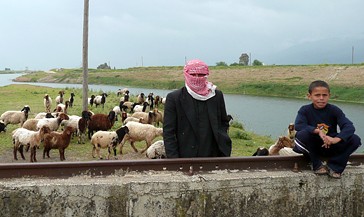
For centuries, families raising crops and livestock in the water-scarce Middle East have struggled to eke out a living. In recent decades, however, that situation has become even more dire, with rising human populations, increasing water demand for both human and industrial use, drought, climate change, expanding deserts, soil depletion, and deteriorating water quality.
Taking on that broad range of challenges is the focus of a recently launched USAID project, the Middle East Water and Livelihoods Initiative (WLI).
The WLI works in seven territories: Egypt, Iraq, Jordan, Lebanon, Syria, the West Bank and Gaza, and Yemen. The project seeks to improve rural livelihoods through better, sustainable land and water management. Those concerns are closely linked in the Middle East. Of the region’s poor, some 60% live in rural areas. About three-quarters of the region’s water supply goes for agricultural uses. Nevertheless, in some of the countries the amount of water available per person has fallen to as little as 170 cubic meters per year. That is far below the generally accepted international definition for “scarcity,” of 1,000 cubic meters per year.
The WLI project team is being led by the International Center for Agricultural Research in the Dry Areas (ICARDA), a major research institute based in the city of Aleppo, Syria. “ICARDA plays a crucial role in terms of the long-standing relationships it has in the Middle East,” said USAID staff member Scott Christiansen, who has worked for ICARDA in the past. Now based in Washington, D.C., Christiansen oversees WLI as part of his duties with the USAID Office of Technical Support of the Asia and Middle East Bureaus.
Also working with ICARDA on WLI are the national agricultural research and extension systems of the participating countries, three leading regional universities in the Middle East, and five U.S. universities that have well-respected degree programs in agriculture.
According to Tareq Bremer, an ICARDA grants management officer for WLI, a key element of the WLI design is its community-based, participatory methodology. For example, project scientists have been working with farmers to identify research topics for the specialists to explore, and WLI staff have been asking the farmers for practical, realistic advice that could be shared with other Middle East countries. “It’s a bottom-up approach,” comments Fadi Karam, the WLI project coordinator for ICARDA. “It links together scientific research, the extension services, and the farmers.”
Mr. Bremer indicated that WLI also takes a much broader perspective on water scarcity than has been true for previous work in the Middle East. For example, many earlier water projects failed to incorporate the livelihoods issue. WLI considers multiple levels, including the field, farm, watershed, and basin. The project takes into account the linkages and interactions among people, resources, and the environment. WLI also considers integrated approaches to increasing both land productivity and water productivity, a strategy known as “more crop per drop.”
Since the WLI’s launch in the fall of 2009, a key focus has been the project’s education and training components. A June 2010 workshop, for instance, explored ways to improve graduate-level university training in agriculture in the seven participating countries. The new training will focus on agriculture, water, and related areas as well teaching methodologies. Among the various technical concerns that WLI participants have identified are saline soils, improved, water-saving irrigation methods, and reusing waste water. Other training will help Middle East university instructors to broaden their teaching skills, such as by learning to use online distance education technology.
Another concern for the Middle East universities and extension services will be to include more women in the training for farmers. “Often because of cultural concerns,” said Sandra Russo, Director of Program Development of the International Center at the University of Florida, “that hasn’t been done much before in the Middle East. For example, you can call a meeting but only men will attend. The men may or may not share the new information they’ve learned with their wives.”
In seeking support for WLI from within USAID, Scott Christiansen emphasized that WLI fits into the major foreign policy initiatives of President Obama and the U.S. Congress, such as the Senator Paul Simon Water for the Poor Act and Feed the Future. It also aligns with plans that USAID and the U.S. State Department have to establish a new scientific center for excellence on water in the Middle East.
“Over the next 10 years,” said Christiansen, “there is a need to build a new generation of water and land management specialists in the Middle East who can better link new research findings with farmers’ adaptation and utilization of that new knowledge.”
Achieving that vision could go a long way toward resolving the issue of scarce water supplies for agriculture in the Middle East.
B Black
For more information, visit:
Middle East Water and Livelihoods Initiative (WLI) website:
http://www.icarda.org/WLI
Links to a collection of Web resources on agriculture, the environment, and water:
http://www.scidev.net/en/agriculture-and-environment/water/
Book, Water for Food, Water for Life: A Comprehensive Assessment of Water Management in Agriculture, published by Earthscan and the International Water Management Institute:
http://www.iwmi.cgiar.org/assessment/







Comment
Make a general inquiry or suggest an improvement.